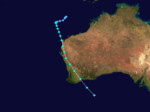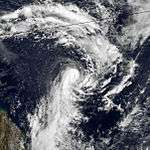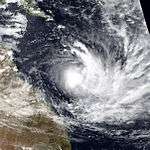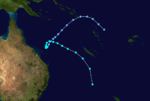1989–90 Australian region cyclone season
| |
| Season summary map |
| First system formed |
July 14, 1989 |
| Last system dissipated |
April 18, 1990 |
| Strongest storm1 |
Alex – 925 hPa (mbar), 240 km/h (150 mph) (10-minute sustained) |
| Tropical lows |
14 |
| Tropical cyclones |
5 |
| Severe tropical cyclones |
1 |
| Total fatalities |
Unknown |
| Total damage |
Unknown |
| 1Strongest storm is determined by lowest pressure |
Australian region tropical cyclone seasons
1987–88, 1988–89, 1989–90, 1990–91, 1991–92 |
| Related articles |
|
|
The 1989–90 Australian region cyclone season was slightly above average. It was also an event in the ongoing cycle of tropical cyclone formation. It ran from 1 November 1989 to 30 April 1990. The regional tropical cyclone operational plan also defines a tropical cyclone year separately from a tropical cyclone season, and the "tropical cyclone year" ran from 1 July 1989 to 30 June 1990.
Tropical cyclones in this area were monitored by four Tropical Cyclone Warning Centres (TCWCs): the Australian Bureau of Meteorology in Perth, Darwin, and Brisbane; and TCWC Port Moresby in Papua New Guinea.
Seasonal summary
Tropical Storm 02S
| Tropical storm (SSHWS) |
|
|
| Duration |
July 14 – July 16 |
| Peak intensity |
65 km/h (40 mph) (1-min) 997 hPa (mbar) |
Tropical Storm 02S existed from July 14 to July 16.
Tropical Cyclone Pedro
| Category 2 tropical cyclone (Australian scale) |
| Category 1 tropical cyclone (SSHWS) |
|
|
| Duration |
November 4 – November 13 |
| Peak intensity |
110 km/h (70 mph) (10-min) 982 hPa (mbar) |
Tropical Cyclone Pedro existed from November 4 to November 13.
Tropical Cyclone Felicity
| Category 2 tropical cyclone (Australian scale) |
| Tropical storm (SSHWS) |
|
|
| Duration |
13 December – 20 December |
| Peak intensity |
110 km/h (70 mph) (10-min) 975 hPa (mbar) |
On 13 December, the BoM started to monitor a monsoon low, that had developed within the Arafura Sea to the northeast of Darwin.[1] Over the next day, the system moved southeastwards over the Northern Territory, before it re-curved slightly and entered the Gulf Of Carpentaria.[1] Early on 15 December, the system was named Felicity by TCWC Brisbane, after it had become a category 1 tropical cyclone on the Australian Scale.[1] During that day the JTWC initiated advisories on the system and designated it as Tropical Cyclone 07P, with peak 1-minute sustained wind speeds of 110 km/h (70 mph).[2] TCWC Brisbane subsequently reported peak 10-minute sustained wind speeds of 110 km/h (70 mph), before the system made landfall over the Cape York Peninsula where weakened below cyclone intensity.[1] The system subsequently moved into the Coral Sea during 16 December, where it started to rapidly deepen, but did not reattain the classical characteristics of a tropical cyclone.[1][3] As a result, both TCWC Nadi and TCWC Brisbane treated the system as a tropical depression over the next four days despite winds of between 110 and 115 km/h (68 and 71 mph) being observed in the southwest quadrant.[1][3] Felicity subsequently dissipated during 20 December as it was absorbed by a short-wave trough of low pressure to the north of New Zealand.[1][3] Some minor damage to vegetation was recorded on the Cape York Peninsular.[1][3]
Tropical Cyclone Rosita
| Category 2 tropical cyclone (Australian scale) |
|
|
| Duration |
January 4 – January 17 |
| Peak intensity |
95 km/h (60 mph) (10-min) 988 hPa (mbar) |
Rosita, 4 to 17 January 1990, Indian Ocean
Severe Tropical Cyclone Sam
| Category 3 severe tropical cyclone (Australian scale) |
| Tropical storm (SSHWS) |
|
|
| Duration |
January 11 – January 21 |
| Peak intensity |
150 km/h (90 mph) (10-min) 966 hPa (mbar) |
Sam, 11 to 21 January 1990, near Western Australia
Tropical Cyclone Tina
| Category 2 tropical cyclone (Australian scale) |
| Tropical storm (SSHWS) |
|
|
| Duration |
January 24 – January 29 |
| Peak intensity |
100 km/h (65 mph) (10-min) 972 hPa (mbar) |
Tina, 24 to 29 January 1990, crossed Western Australia
Tropical Cyclone Nancy
| Category 2 tropical cyclone (Australian scale) |
| Category 1 tropical cyclone (SSHWS) |
|
|
| Duration |
January 26 – February 4 |
| Peak intensity |
110 km/h (70 mph) (10-min) 975 hPa (mbar) |
On February 3, 1990, Cyclone Nancy made landfall near Byron Bay, bringing flashfloods that killed five people.
Severe Tropical Cyclone Vincent
| Category 3 severe tropical cyclone (Australian scale) |
| Category 1 tropical cyclone (SSHWS) |
|
|
| Duration |
February 25 – March 6 |
| Peak intensity |
150 km/h (90 mph) (10-min) 965 hPa (mbar) |
Vincent, 25 February to 6 March 1990, near Western Australia
Tropical Cyclone Greg
| Category 1 tropical cyclone (Australian scale) |
| Tropical depression (SSHWS) |
|
|
| Duration |
February 28 – March 5 |
| Peak intensity |
75 km/h (45 mph) (10-min) 990 hPa (mbar) |
Greg, 28 February to 5 March 1990, Gulf of Carpentaria
Tropical Cyclone Walter-Gregoara
| Category 2 tropical cyclone (Australian scale) |
| Tropical storm (SSHWS) |
|
|
| Duration |
March 4 – March 13 (Exited basin) |
| Peak intensity |
100 km/h (65 mph) (10-min) |
Walter, 3 to 27 March 1990, Indian Ocean
Tropical Cyclone Hilda
| Category 2 tropical cyclone (Australian scale) |
| Tropical storm (SSHWS) |
|
|
| Duration |
March 4 – March 7 |
| Peak intensity |
110 km/h (70 mph) (10-min) 970 hPa (mbar) |
Cyclone Hilda had cloud tops estimated at 62,000 feet tall. The measured cloud top temperature was -152 °F, which is the coldest cloud-top temperature ever measured.
Severe Tropical Cyclone Alex
| Category 5 severe tropical cyclone (Australian scale) |
| Category 4 tropical cyclone (SSHWS) |
|
|
| Duration |
March 14 – March 26 |
| Peak intensity |
215 km/h (130 mph) (10-min) 925 hPa (mbar) |
Alex was a fairly intense system. It existed from 14 to 26 March 1990. Despite the intensity, Alex never caused significant damage.
Severe Tropical Cyclone Ivor
| Category 3 severe tropical cyclone (Australian scale) |
| Category 1 tropical cyclone (SSHWS) |
|
|
| Duration |
March 14 – March 26 |
| Peak intensity |
130 km/h (80 mph) (10-min) 965 hPa (mbar) |
Ivor, 14 to 26 March 1990, crossed Cape York, Queensland
Tropical Cyclone Bessi
| Category 1 tropical cyclone (Australian scale) |
| Tropical storm (SSHWS) |
|
|
| Duration |
April 11 – April 18 |
| Peak intensity |
85 km/h (50 mph) (10-min) 990 hPa (mbar) |
Bessi, 11 to 18 April 1990, Indian Ocean
See also
References
- 1 2 3 4 5 6 7 8 Tropical Cyclone Felicity (Report). Australian Bureau of Meteorology. Archived from the original on 7 April 2012. Retrieved 26 May 2014.
- ↑ Joint Typhoon Warning Center; Naval Pacific Meteorology and Oceanography Center. Annual Tropical Cyclone Report: 1990 (PDF) (Report). United States Navy, United States Air Force. p. 234. Retrieved 26 May 2014.
- 1 2 3 4 Singh, Arveen K; Fiji Meteorological Service (Summer 1990). DeAngellis, Richard M, ed. "Tropical depression in Coral Sea (former T.C. Felicity), December 18–20, 1989" (Mariners Weather Log). 34 (3). United States National Oceanic and Atmospheric Administration's National Oceanographic Data Service: 48. hdl:2027/uiug.30112104094245.





























